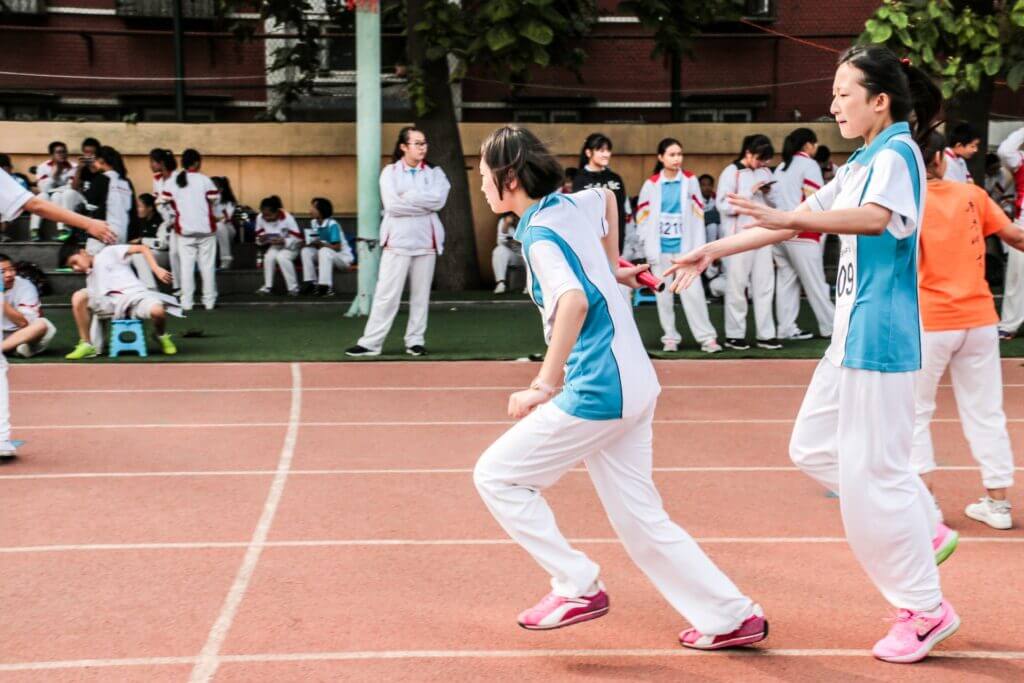Are you a runner who’s been debating whether your favorite pastime qualifies as a sport? Or maybe you’re someone who’s always wondered why running is considered a sport at all.
Well, you’re not alone! The topic of whether running is a sport has been a subject of heated debate for years, and it’s not hard to see why. After all, running can be as simple as a quick jog around the block, or as grueling as a 26.2-mile marathon. So, is running a sport, or is it just exercise?
In this blog post, we’ll explore seven factors that may help settle the debate once and for all. From physical demands to governing bodies, we’ll examine the key characteristics that define a sport and see how running stacks up.
So whether you’re a seasoned runner or just someone curious about the definition of a sport, grab your running shoes and let’s dive in!
Table of Contents
Factor 1: Physical demands

Physical demands are a crucial aspect of any sport. Physical demands refer to the level of physical exertion and the intensity of the activity required to compete in a particular sport. Running is a sport that requires a high level of physical demand from its participants. Here are some reasons why running meets the physical demands criteria:
- Endurance
Running requires a high level of endurance. Endurance is the ability to maintain a high level of physical activity for an extended period. Endurance is developed by training the cardiovascular and respiratory systems. Running is a sport that requires a significant level of cardiovascular and respiratory endurance. Running long distances requires the runner to maintain a high level of physical activity for an extended period.
- Speed
Running is a sport that requires speed. Speed is the ability to move quickly. Running requires the runner to move their body at a high speed. Sprinting is a type of running that requires the runner to move their body at high speed for a short distance.
- Strength
Running also requires strength. Strength is the ability to apply force to move an object. Running requires the runner to apply force to move their body. Running long distances requires the runner to have sufficient leg strength to propel their body forward.
Many running events require a high level of physical demand from their participants. Marathons, ultramarathons, and triathlons are examples of running events that require a high level of physical demand. Participants in these events must train for months to develop the necessary physical endurance, speed, and strength to compete.
In short, running is a sport that meets the physical demands criteria. Running requires a high level of endurance, speed, and strength. Running events such as marathons and triathlons require months of training to develop the necessary physical abilities to compete. The physical demands of running make it a sport that requires dedication and commitment from its participants.
Factor 2: Competition

Competition is a defining characteristic of sports. It refers to the presence of one or more opponents who are competing against each other to achieve a common goal. In the context of running, competition can take many different forms.
One of the most common forms of running competition is the road race. Road races can range in distance from 5K to a full marathon (26.2 miles). These races typically have a large number of participants and are often held for charitable causes. Runners are timed and ranked based on their finishing times, with the fastest runners receiving prizes or recognition.
Another form of running competition is track and field. This type of competition takes place on a track and includes various events, such as sprints, middle-distance running, long-distance running, and relays. In track and field events, runners typically compete against each other, but also against their personal best times.
Cross-country running is another type of competition that involves running on natural terrain such as dirt trails, grass, and hills. Cross-country running events can range in distance, the most common being 5K and 10K races. In cross-country running, runners compete against each other, but also against the challenging terrain of the course.
Ultra-running is another form of running competition that involves running long distances over extended periods. Ultra-running events can range from 50K to 100 miles or more. Runners often compete against each other, but also against the physical and mental challenges of running such a long distance.
Overall, it’s clear that running is a competitive activity. Runners often train and prepare for competitions with the goal of improving their performance and beating their opponents. The presence of competition is a key factor in the classification of running as a sport.
Factor 3: Governing body

For an activity to be considered a sport, it typically needs to have a recognized governing body that oversees the rules and regulations of the activity. This governing body helps to standardize competition and ensure fair play, which are important elements of any sport. So, does running have a recognized governing body?
The answer is somewhat complicated. While there are certainly organizations that oversee running competitions, such as the International Association of Athletics Federations (IAAF) and USA Track & Field (USATF), running as an activity does not have a single, global governing body.
The IAAF is the international governing body for track and field, which includes running events such as sprints, middle-distance, and long-distance races. USATF is the national governing body for track and field in the United States. Both organizations set rules and regulations for running competitions, including how races are organized, what equipment can be used, and what is considered fair play.
However, many other organizations also organize running competitions, and each of these organizations may have slightly different rules and regulations. Additionally, many informal running groups and clubs organize their races and events without any oversight from a governing body.
So, while there is no one governing body that oversees all running competitions, there are still recognized organizations that set standards for the sport. The question of whether this is sufficient to classify running as a sport is up for debate. Some argue that the lack of a single governing body means that running is not a true sport, while others contend that the existence of recognized organizations is enough to classify it as such.
Ultimately, the presence or absence of a governing body is just one factor to consider when determining whether running should be classified as a sport. In the next section, we’ll explore the role of skill level in this debate.
Factor 4: Skill level

In sports, skill level refers to the level of proficiency an athlete has in a particular set of skills necessary to perform the sport successfully. This includes physical attributes such as speed, strength, and endurance, as well as technical skills such as coordination, balance, and agility.
While running may seem like a simple activity that anyone can do, it requires a certain level of skill to perform it well. This includes having good running form, pacing oneself correctly, and knowing how to breathe properly. Additionally, long-distance runners must be able to maintain a consistent pace over a prolonged period, which requires significant physical and mental endurance.
The level of skill required to run at a high level is certainly significant, and certain events and competitions require a high level of skill and ability to win. However, it could be argued that running does not require the same level of technical skill as other sports such as gymnastics, figure skating, or diving. Furthermore, while there are certainly highly skilled runners who compete at an elite level, it’s also true that many people can complete a marathon or half marathon without necessarily possessing exceptional skill.
Overall, while running does require a certain level of skill, it’s debatable whether this is enough to classify it as a sport on its own. However, when considered alongside other factors such as physical demands, competition, and training and preparation, it becomes clear that running should be considered a legitimate sport in its own right.
Factor 5: Teamwork

In the context of sports, teamwork refers to the ability of players or athletes to work together towards a common goal. In team sports, this involves players collaborating to achieve victory, and in individual sports, it can refer to the support and guidance provided by coaches, trainers, and other support staff.
Running is often thought of as an individual sport, with each runner competing against the clock and striving to improve their personal best time. However, there are also team-based running events, such as relay races and cross-country meets, where runners compete as part of a group.
In a relay race, for example, runners take turns completing a section of the race before passing the baton to the next runner. The team’s overall time is determined by the combined efforts of all the runners. In cross-country meets, runners compete as part of a team, with each runner’s finishing position contributing to the team’s overall score.
The presence or absence of teamwork does not necessarily affect the classification of running as a sport. While some may argue that the lack of team-based events means that running should not be considered a sport, others would argue that individual sports such as running can still be highly competitive and require a high level of skill and physical ability.
Ultimately, whether running is classified as a sport or not is dependent on a range of factors, and the presence or absence of teamwork is just one of many considerations. However, it is important to note that team-based running events can be a valuable way for runners to build camaraderie and support each other in their athletic pursuits.
Factor 6: Training and preparation

In addition to physical demands, competition, governing bodies, skill level, teamwork, recognition, training, and preparation are important factors to consider when classifying an activity as a sport.
Running requires a significant amount of training and preparation to compete at a high level. Elite runners spend many hours each week training, often under the guidance of coaches and trainers. This training may include long runs, speed workouts, strength training, and cross-training activities such as swimming or cycling. Runners also need to carefully manage their nutrition and hydration, particularly when training for a marathon or other long-distance event.
The level of training and preparation required for running competitions is often equivalent to that of other recognized sports. For example, training for a marathon may require as much dedication and preparation as training for a triathlon or a cycling race. Some runners argue that the level of commitment required to become a competitive runner is on par with other more traditional sports such as football or basketball.
Moreover, the level of competition in the running is often high, with athletes pushing themselves to their physical limits to win races. The intense physical and mental demands of running competitions require significant training and preparation to be successful.
However, some may argue that the level of training and preparation required for running is not sufficient to classify it as a sport. Compared to other sports, running may require less specialized equipment and less formal training. Additionally, some may argue that the physical demands of running are not as complex as those required for other sports such as gymnastics or figure skating.
Despite these arguments, it is clear that running requires a significant level of training and preparation to compete at a high level. Whether this is sufficient to classify running as a sport is a matter of debate, and depends on how we define the concept of “sport” itself.
Factor 7: Recognition and acceptance
Recognition refers to the acknowledgment and acknowledgment of a particular activity or competition as a legitimate sport. Acceptance, on the other hand, refers to the level of widespread acceptance of the activity or competition as a sport by athletes, fans, and the wider sporting community.
Running is one of the most popular physical activities around the world, and there are a vast number of running events that take place throughout the year. However, the question remains whether running is recognized and accepted as a sport.
The recognition and acceptance of running as a sport varies depending on different factors, including cultural and geographic differences. In some countries, running is widely recognized and accepted as a sport, with numerous elite athletes and competitive events. In contrast, other countries may view running as simply an exercise activity rather than a competitive sport.
The level of recognition and acceptance of running as a sport affects how it is classified. If running is widely recognized and accepted as a sport, it is more likely to be classified as such. However, if running is seen more as an exercise activity, it may not be considered a sport.
The level of recognition and acceptance of running as a sport also impacts the resources and support available for athletes who participate in the sport. If running is widely recognized and accepted as a sport, then there may be more funding and sponsorship opportunities for athletes, which can help to promote the development of the sport.
Overall, while running is a popular physical activity, whether it is recognized and accepted as a sport varies depending on factors such as cultural and geographic differences. The level of recognition and acceptance affects how running is classified and impacts the resources and support available to athletes.
Conclusion
In conclusion, the debate over whether running should be classified as a sport is a complex and multifaceted one. After considering the seven factors discussed in this post, it becomes clear that there are valid arguments both for and against classifying running as a sport.
On the one hand, running meets many of the criteria traditionally associated with sports, such as physical demands, competition, and training and preparation. Furthermore, running is a highly popular and widely recognized activity, with many different types of races and competitions taking place all over the world.
On the other hand, some might argue that running lacks certain key features that are often associated with sports, such as the presence of a governing body or the requirement for teamwork. Additionally, there is a perception that running is more of an individual activity than a team one, which could potentially affect its classification as a sport.
Ultimately, whether or not running is considered a sport may depend on individual perspectives and definitions of what constitutes a sport. While some may argue that running is a sport, others may take a more nuanced approach and acknowledge that it has elements of both sport and exercise.
In my personal opinion, I believe that running should be classified as a sport. The physical demands, competition, and training required for running all suggest that it meets the criteria for being a sport. However, I also acknowledge that there are valid arguments against classifying running as a sport and that this is ultimately a subjective and nuanced debate.
What do you think? Do you believe that running is a sport? I encourage you to share your thoughts and opinions in the comments section below.


